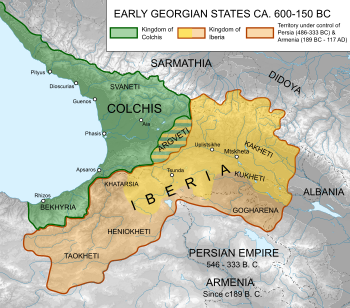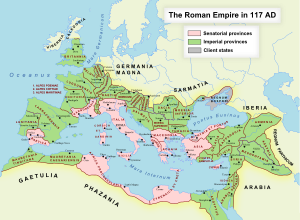Kingdom of Iberia facts for kids
Quick facts for kids
Kingdom of Iberia
ქართლის სამეფო
kartlis samepo |
|||||||||||
|---|---|---|---|---|---|---|---|---|---|---|---|
| c. 302 BC–580 AD | |||||||||||
|
Flag of the kingdom after the Christianization of Iberia
|
|||||||||||

Colchis and Iberia
|
|||||||||||
| Status |
(302–159 BC)
(65–63 BC, 40–36 BC, 30–1 AD)
(1–129 AD, 131–260 AD)
(260–265 AD)
(298–363 AD)
(363–482 AD, 502–523 AD)
(523–580 AD) |
||||||||||
| Capital | Armazi Mtskheta Tbilisi |
||||||||||
| Common languages | Old Georgian | ||||||||||
| Government | Monarchy | ||||||||||
| Historical era | Antiquity | ||||||||||
|
• Reign of Pharnavaz I
|
c. 302 BC | ||||||||||
|
• Christianization of Iberia during reign of Mirian III
|
317 AD | ||||||||||
|
• Direct Sasanian control and abolition of the monarchy.
|
580 AD | ||||||||||
|
|||||||||||
In ancient times, the land we now call Georgia was home to a powerful kingdom. This kingdom was known as Iberia (or Kartli). It was a very important monarchy in the Caucasus region.
Iberia existed during Classical Antiquity and the Early Middle Ages. It was sometimes an independent state. Other times, it was controlled by larger empires. These included the Sassanid and Roman empires. Iberia was located in what is now Eastern Georgia. It bordered Colchis to the west. To the east was Caucasian Albania, and to the south was Armenia.
The people of Iberia were called the Iberians. They were the main group of the Kartvelians, who are the ancestors of today's Georgians. Different royal families ruled Iberia. These included the Pharnavazid, Artaxiad, Arsacid, and Chosroid dynasties. Later, Iberia and Colchis joined together. They formed the unified medieval Kingdom of Georgia. This new kingdom was led by the Bagrationi dynasty.
In the 4th century AD, something big happened. Saint Nino brought Christianity to Iberia. King Mirian III made Christianity the official state religion. This changed the kingdom forever.
By the early 6th century AD, Persia took direct control. In 580 AD, King Hormizd IV ended the monarchy. Iberia became a Persian province. It was then ruled by a governor called a marzpan.
The name "Caucasian Iberia" helps us tell it apart. It is different from the Iberian Peninsula in Europe.
Contents
What's in a Name?
The exact origin of the name "Iberia" is not fully clear. One idea is that it comes from the Armenian word "Virkʿ". This word was used for Georgia. It might be linked to "Sver" or "Svir", which Georgians used for themselves.
Some historians also think the name "Iberian" was given by ancient Greeks. They might have used it for two different groups of people. These groups lived far apart. One was in the Iberian Peninsula. The other was in the Caucasus. Both places were known for their legendary wealth.
A Look at Iberia's Past
Early Beginnings
In ancient times, many related tribes lived in Caucasian Iberia. They came from the Kura-Araxes culture. The Saspers, mentioned by the historian Herodotus, may have helped unite these tribes. The Moschoi might have moved northeast. They formed settlements like Mtskheta. Mtskheta later became the capital of Iberia. Its local ruler was called a mamasakhlisi, meaning "father of the household."
Old Georgian stories tell us about Iberia's early days. These stories are part legend. One story says a ruler named Azo came from Arian-Kartli. He settled where Mtskheta was built. Another story says Azo was an officer for Alexander the Great. He conquered the area. But Prince Pharnavaz defeated him in the late 4th century BC.
These stories about Alexander are mostly legends. But they show how the Georgian monarchy began. It started during the Hellenistic period. Later Georgian writers wanted to connect their history to a famous conqueror.
Pharnavaz won a big power struggle. He became the first king of Iberia. This was around 302 BC. Georgian stories say he pushed back invaders. He also took control of nearby areas. This included parts of Colchis, a western Georgian state. It seems the Seleucids from Syria recognized his new kingdom.
Pharnavaz is also said to have built a strong fortress. It was called the Armaztsikhe. He also built a temple to the god Armazi. He created a new way to run the country. He divided it into regions called saeristavos.
His family, the Pharnavazids, controlled important mountain passes. The Daryal pass, also known as the Iberian Gates, was very important.
After this time of success, Iberia faced many wars. It had to defend itself from invasions. Some southern parts of Iberia were lost to Armenia. Colchis also broke away. In the late 2nd century BC, King Pharnajom was removed from power. This happened after he converted to Zoroastrianism. The crown was given to an Armenian prince, Artaxias. He started the Artaxiad dynasty of Iberia in 93 BC.
Rome and Persia's Influence

Iberia's close ties with Armenia and Pontus led to a Roman invasion. The Roman general Pompey invaded in 65 BC. He was fighting against Mithradates VI of Pontus and Armenia. But Rome did not stay in control of Iberia for long. Twenty-nine years later, the Romans returned. They forced King Pharnavaz II to join their fight against Albania.
Colchis, another Georgian kingdom, became a Roman province. But Iberia chose to accept Roman protection. An old stone writing found in Mtskheta tells us about a 1st-century ruler. King Mihdrat I (AD 58–106) was called "the friend of the Caesars." He was also called the king "of the Roman-loving Iberians." Emperor Vespasian even strengthened the old Mtskheta site of Arzami for the Iberian kings in AD 75.
For the next two centuries, Rome continued to influence Iberia. But by the time of King Pharsman II (116–132), Iberia had become powerful again. Relations between Emperor Hadrian and Pharsman II were difficult at first. But they improved under Hadrian's successor, Antoninus Pius. Pharsman even visited Rome. A statue was built in his honor there. Rome began to see Iberia as an ally, not a subject state. This continued even when Rome fought the Parthians.
During these centuries, two religions were common in Iberia. These were Mithras worship and Zoroastrianism. Silver cups found in old burial sites show horses near fire altars. This suggests the worship of Mithras. This religion blended with local Georgian beliefs. It may have been a step towards the worship of St. George. Iranian customs and beliefs also became popular. The Iberian court and noble families adopted Iranian styles. They used Iranian names. The official worship of Armazi was introduced by King Pharnavaz. This was connected to Zoroastrianism.
Between Empires: Rome, Byzantium, and Persia
A big change for Iberia came in 224 AD. The Sasanian (or Sassanid) Empire was founded by Ardashir I. This strong new state changed Iberia's focus away from Rome. Iberia became a state that paid tribute to the Sasanian Empire. This happened during the rule of Shapur I (241–272). At first, relations seemed friendly. Iberia helped Persia fight Rome. King Amazasp III (260–265) was a high official in the Sasanian Empire. But the Sasanians also pushed their religion, Zoroastrianism. It became popular in Iberia between 260 and 290 AD.
However, in 298 AD, the Peace of Nisibis treaty was signed. The Roman Empire regained control of Caucasian Iberia. It was a vassal state again. The treaty recognized Mirian III as king of Iberia. He was the first king of the Chosroid dynasty.
Christianity Arrives and Persian Rule Returns
Roman influence was key in religion. King Mirian III and other nobles became Eastern Orthodox Christians around 317 AD. They made Orthodoxy the official state religion. This happened because of Saint Nino, a woman from Cappadocia. She had been teaching Christianity in Iberia since 303 AD.
Christianity created a strong bond between Georgia and Rome (later Byzantium). It greatly affected the country's culture. Iranian art styles slowly disappeared after Christianity was adopted.
But in 363 AD, the Roman emperor Julian died in Persia. Rome then gave control of Iberia to Persia. King Varaz-Bakur I (363–365) became a Persian vassal. This was confirmed by a peace treaty in 387 AD. However, a later ruler, Pharsman IV (406–409), kept his country's freedom. He stopped paying tribute to Persia.
But Persia eventually gained power again. Sasanian kings started appointing a viceroy, called a pitiaxae. This person watched over their vassal. They made this position hereditary. This created the Kartli pitiaxate. It controlled a large area. Even though it was part of Kartli, its viceroys spread Persian influence. Sasanian rulers also challenged the Georgians' Christianity. They promoted Zoroastrianism. By the mid-5th century, Zoroastrianism became a second official religion in eastern Georgia. It was alongside Eastern Orthodoxy.
The early rule of King Vakhtang I, also known as Gorgasali (447–502), brought a revival. He was officially a Persian vassal. But he secured the northern borders. He brought western and southern Georgian lands under his control. He created an independent patriarchate in Mtskheta. He also made Tbilisi his capital. In 482, he led a revolt against Persia. He fought for independence for twenty years. But he did not get help from Byzantium. He was defeated and died in battle in 502.
The Kingdom's End
The ongoing fight between Byzantium and Sasanian Persia for control of the Caucasus hurt Iberia. Another Georgian uprising in 523, led by Gurgen, also failed. After this, the king of Iberia had very little power. Persia effectively ruled the country. In 580 AD, King Hormizd IV ended the monarchy. This happened after King Bakur III died. Iberia became a Persian province. It was ruled by a governor called a marzpan.
Georgian nobles asked the Byzantine emperor Maurice to bring back the kingdom in 582. But in 591, Byzantium and Persia agreed to divide Iberia. Tbilisi went to Persia, and Mtskheta went to Byzantium.
In the early 7th century, the peace between Byzantium and Persia ended. The Iberian Prince Stephanoz I (c. 590 – 627) joined forces with Persia in 607. He wanted to reunite all of Iberia. He seemed to succeed. But Emperor Heraclius attacked in 627 and 628. He defeated the Georgians and Persians. This gave Byzantium control over western and eastern Georgia. This lasted until the Arabs invaded the Caucasus.
Arab Rule and a New Beginning
The Arabs reached Iberia around 645 AD. They forced its prince, Stephanoz II (637 – c. 650), to stop supporting Byzantium. He had to recognize the Caliph as his ruler. Iberia became a state that paid tribute. An Arab emir was placed in Tbilisi around 653 AD.
In the early 9th century, Prince Ashot I (813–830) rose to power. He was from the new Bagrationi dynasty. He took advantage of weakening Arab rule. He became the hereditary prince of Iberia. A later ruler, Adarnase IV of Iberia, was crowned "king of Iberia" in 888. He was officially a vassal of Byzantium. His descendant, Bagrat III (ruled 975–1014), united the different regions. He formed a single Georgian monarchy.
Eastern and Western Iberians
The name "Iberia" is also used for ancient people in the Iberian Peninsula in Europe. These are sometimes called the 'Western' Iberians. This similarity has led to ideas that the 'Eastern' Iberians of the Caucasus and the 'Western' Iberians might be related.
Many ancient and medieval writers supported this idea. It was popular in medieval Georgia. A famous Georgian writer, George the Hagiorite (1009–1065), wrote about Georgian nobles. They wanted to travel to the Iberian Peninsula. They wanted to visit the local "Georgians of the West," as he called them.
See also
 In Spanish: Reino de Iberia para niños
In Spanish: Reino de Iberia para niños
- Georgian monarchs family tree of Iberia
- Colchis
- Roman Georgia
- Sasanian Iberia



